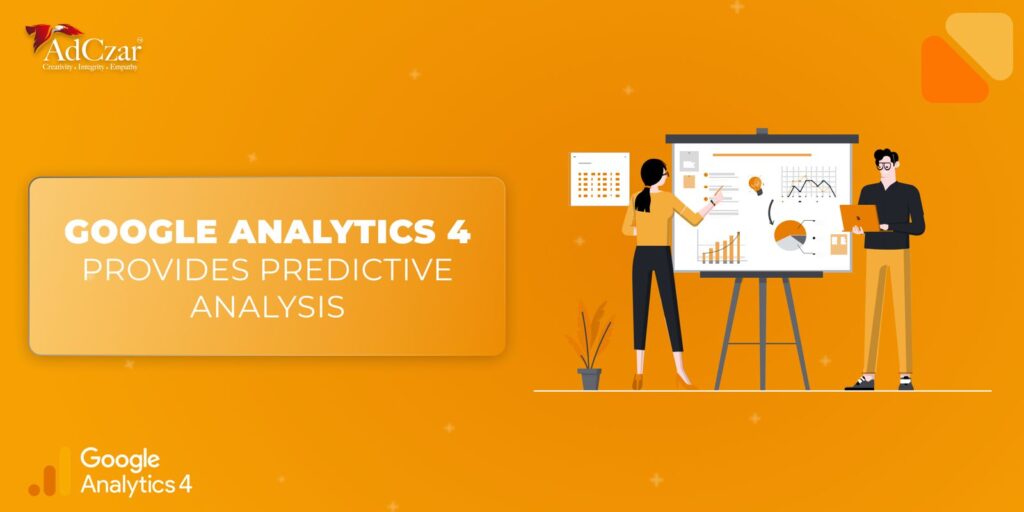
Google Analytics 4 is the latest version of Google’s popular website analytics platform. It will replace Google Analytics from 1st July 2023 and is the need of the hour for digital marketers. With the latest iteration of Google Analytics, GA4, you have access to a robust platform that combines machine learning, advanced analytics, and cross-platform tracking capabilities to provide you with a holistic view of your audience.
With the Google Analytics 4 training, you can maintain the entire customer path across multiple platforms and machine learning to make a more detailed report about how users interact with business applications and websites. It is a tool that provides insights with cross-channel data measurement, AI-driven predictive analytics, and privacy-first tracking.
Whether you’re a seasoned marketer, an e-commerce entrepreneur, or a website owner looking to optimize your online performance, this Google Analytics 4 guide by the AdCzar will walk you through the key features, best practices, and practical tips to harness the full potential of Google Analytics 4, empowering you to drive growth and achieve your business objectives. However, if you are new to web analytics, this process can seem daunting. That’s where this Google Analytics 4 tutorial comes into use. So, let’s embark on a data-driven journey that will revolutionize the way you analyze and leverage your digital data.
Google Analytics 4 Tutorial: GA vs GA4
The very first difference one gets to see between universal analytics and Google Analytics 4 is the dashboard. The new dashboard is mostly streamlined and previous reports are moved to different locations. In the universal analytics page view, the most important thing was the matrix but with Google Analytics 4, one can get all the measurements in the form of events and fully understand how users interact with the website and application. GA4 has an array of new metrics called events. These include engagement metrics:
-
Engaged session
-
Engagement rates
-
Engagement time
Predictive insights with GA4

Analyzing past behavior and understanding the audience is helpful but it doesn’t provide the ability to make proactive decisions. With predictive metrics in Google Analytics 4 one can make data-driven decisions on a large scale such as:
- Purchase Probability
- Churn probability
- Revenue prediction
Now that we know about the previous and latest version of Google Analytics, let’s dive a bit more deeply into it.
Top Features of Google Analytics 4 Guide
We always work towards getting better and Google Analytics 4 is also for betterment. It is going to be the catalyst of your business. Here are how it can enhance data analysis:
Enhanced Event Tracking
GA4 places a greater emphasis on event tracking, allowing businesses to capture user interactions more effectively. Events can include button clicks, video plays, file downloads, and other actions that users take on the website or app which means as opposed to one view for multiple actions, GA4 will record every action by the user on the website/app. This level of granularity provides detailed insights into user behavior and engagement.
Machine Learning and AI Capabilities
GA4 leverages the power of machine learning and AI to provide advanced analytics and predictive insights. It can automatically analyze user behavior patterns, segment audiences based on their characteristics and actions, and generate valuable insights to optimize digital marketing strategies.
Improved Cross-Platform Tracking
With Google Analytics 4, it is possible to track user interactions across multiple platforms, even offline touchpoints. This holistic view helps to understand how users engage with the brand, regardless of the platform they use, enabling better attribution and optimization of marketing efforts.
Deeper Integration with Google Ads and Big Query
Google Analytics 4 offers seamless integration with Google Ads, which lets marketers measure the performance of their ad campaigns more accurately. Additionally, GA4 has improved integration with Google BigQuery, a powerful data analytics warehouse, facilitating more comprehensive data analysis and exploration.
GA4 Gives Control to Marketers
GA4 allows dashboard customization of the most relevant report according to the business.
It even works well with Google data studio so that one can get a visualization of the collected data. It also creates custom segments based on significant events which are essential for your website and applications this enables one to track customer engagement precisely.
Benefits of Google Analytics 4
- Its cross-platform tracking provides a unified view of the user journey, which will enable you to understand the customer experience from start to finish. This comprehensive perspective will allow for better optimization of marketing channels and customer touchpoints.
- It can create advanced audience segments based on user behavior, demographics, and other attributes. To tailor better marketing campaigns, personalize user experiences, and drive better engagement and conversion rates.
- GA4 comes with some of the latest privacy laws such as GDPR (General Data Protection Regulation) and CCPA (Central Consumer Protection Authority) as it also focuses on customer privacy.
- It uses privacy-centric measurement methodologies and can function effectively with limited data, ensuring compliance and accurate tracking in a privacy-conscious era. In simple words, GA4 keeps user data safe.
- Its machine-learning algorithms can uncover valuable insights and trends that might not be noticed through traditional analysis. These key insights can provide a better base for data-driven decisions, optimize marketing strategies, and drive business growth.
Conclusion
In the end, we can say that Google Analytics 4, brings an exciting data model, better ways to measure user behavior, and features that can be leveraged to make data-driven decisions once you get past the learning curve.
Google Analytics 4 represents a significant leap forward in the world of data analytics. Its cross-platform tracking, enhanced event tracking, and AI capabilities provide businesses with a more comprehensive and accurate understanding of user behavior.
Now that you are familiar with the basics of Google Analytics 4, you can be relaxed about migrating from Universal GA to GA4. Your previous data will remain available on Universal GA for the next one year so you need not fret.
If you liked our short yet comprehensive Google Analytics 4 guide, please share it with your friends to help them understand GA4.
In the next blog, we will share more learnings related to Google Analytics 4 to guide you in adapting it seamlessly and leveraging its advanced features to optimize marketing efforts and create personalized experiences for your customers. Watch this space for our series on Google Analytics 4 tutorials and blogs.